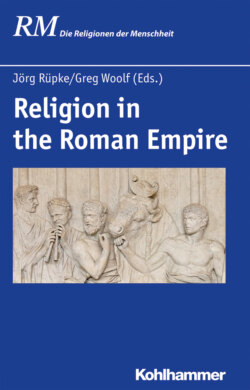Читать книгу Religion in the Roman Empire - Группа авторов - Страница 8
На сайте Литреса книга снята с продажи.
1 Approaching Roman Religion
ОглавлениеHow can we reconstruct the religious dimensions of life in the Roman empire? How were rituals entangled with the routines of everyday living and extraordinary events? How did relations with the divine intrude into the spaces Roman inhabited and the patterns of their lives? How, in short, was Roman religion lived?
Over the last decade a number of excellent general accounts of Roman religion have been produced, themselves building on a rich tradition of scholarship more than a century old. Some of these deal with the same sort of questions that exercised Roman scholars from the last century BCE on, men (and it was always men) such as Marcus Terentius Varro, Marcus Tullius Cicero, Verrius Flaccus and behind them a series of works now known only in fragments. Those first Roman experts on Roman religion were interested in particular priesthoods and religious rules. Why was the flamen of Jupiter not allowed to spend prolonged periods outside the city? They tried to distinguish elements of Greek or Etruscan origin from ancient local customs and more recent innovations. Some Roman writers, and some Greek ones too, tried to explain some more bizarre rituals such as the Lupercalia when young aristocrats ran half naked around the city striking women with leather straps, the Parilia which in some sense (but what sense?) celebrated the birthday of Rome, or the October Horse. And some ancient writers wondered about the origin of the gods, how they were related to similar gods worshipped by other ancient peoples and how to connect traditional myth with modern philosophy. Because the modern study of antiquity began as an exegetical process focused on the Greek and Latin classics, it was natural that much early scholarship dealt with the same questions that had puzzled the ancients.1
Parallel to that sort of investigation have been attempts to capture the broader pattern of Roman religion by standing outside it. An influential tradition, one we may trace back to Fustel de Coulanges (1864), found the key to Roman (and Greek) religion in the structures of the city state.2 If ancient cities were fundamentally, perhaps even in origin, communities of coreligionists, then much of the shape of ancient religion could be understood as calqued on or coterminous with the shape of ancient civic societies. The boundaries of the citizen body coincided with the boundaries of participants in collective ritual or the boundaries of those whose religious actions had consequences for the community. Generally the same groups and individuals that controlled a given city-state—aristocrats and the senate in Rome, the demos and the ecclesia in Athens—controlled ritual. The most recent formulations along these lines—sometimes termed ›civic religion‹ or ›la religion poliade‹—remain influential.3 There are naturally many variations: some scholars treat this as a harmonious homology between the religious, the social and the political, a sign that these spheres were weakly differentiated in ancient thought, or that ritual was deeply embedded in social structure and political order. Some see polis religion as an ideological construction, created to serve the interests of the powerful and to legitimate their control of the state, always opposed to a less sharply defined field of heterodox views, deviant practices, superstitions and the like. Given most of our written sources for Roman religion derived from members of those ruling elites it is not always easy to know—at least not from texts alone—how contested their views of religion were.
The best modern accounts of Roman religion make the most of the written evidence for ancient belief and cult but do not allow these texts to determine the questions we might ask. One way to escape ancient definitions of the subject is to deploy comparative evidence. Greek, Roman and Etruscan rituals have long been compared, and at one time it was common to broaden the field of comparison to include other religions regarded as of common Indo-European descent. Fewer scholars are now comfortable with moving easily from a linguistic taxonomy to a family of related societies: in that sense the legacy of Dumézil4 is almost extinct. It has also become less common to explain Roman religion in terms of its supposed origins (Etruscan, rustic, Indo-European etc.).5 Most experts on Roman religion now try to elucidate particular rituals and institutions in terms of their contemporary context. So the Lupercalia as practiced in the late Republic has to have a significance in terms of the collective life of a city of several hundred thousand at the heart of vast and expanding empire, led by an elite self-consciously engaged in the creation of a distinctive cultural tradition that might rival that of the Greeks. The key question now is how to balance these contexts: which explain most, the urban? the imperial? the intellectual? or a mixture of these and others? Now we mostly approach Roman religion through synchronic rather than diachronic analysis, trying to understand rituals and utterances in the context of their performance, and we read texts not as authorities so much as as momentary crystallizations of discourse.6 Our focus on the wider context and the contemporary has meant that the social sciences—especially anthropologies of various kinds—have provided powerful tools for interpreting and imagining Roman religion.
